Book contents
- Frontmatter
- Contents
- Acknowledgements
- List of Tables and figures
- Map
- Introduction
- 1 Power versus markets
- 2 Russian economic reform in historical perspective
- 3 How Putin’s economy is governed: commanding heights and controlling elites
- 4 Measuring Putin’s economy: the victory of resilience over growth
- 5 Social factors in Putin’s Russia
- 6 The Russia you see is the Russia you get: formalizing informality and informalizing power via sistema
- Conclusion: resilience, war and Russia’s future
- Chronology of Russian history
- Notes
- References
- Index
2 - Russian economic reform in historical perspective
Published online by Cambridge University Press: 20 January 2024
- Frontmatter
- Contents
- Acknowledgements
- List of Tables and figures
- Map
- Introduction
- 1 Power versus markets
- 2 Russian economic reform in historical perspective
- 3 How Putin’s economy is governed: commanding heights and controlling elites
- 4 Measuring Putin’s economy: the victory of resilience over growth
- 5 Social factors in Putin’s Russia
- 6 The Russia you see is the Russia you get: formalizing informality and informalizing power via sistema
- Conclusion: resilience, war and Russia’s future
- Chronology of Russian history
- Notes
- References
- Index
Summary
Peter the Great’s first task in establishing an imperial state was to find a way of formalizing the relationships between the nobility and landowning class, existing but weak state institutions, such as the treasury and tax collection, and the thinly distributed class of bureaucrats governing Russia. The pre-Petrine state commanded a vast territory that was under-governed and institutionally backwards relative to other European imperial powers. Fiscal and financial power was decentralized among tens of regional chanceries managed by individuals appointed by the tsar far from the royal court. Informal networks between merchants, state officials, the nobility, and the royal family held the state together. Peter sought to build an imperial state modelled on European empires’ formal institutions. He did so, but instead of eliminating the informality of Russia’s governance, he imposed a formal structure onto it. A newly centralized treasury and state bureaucracy provided the facade of new institutional structures, while much business continued as usual “under the rug” and traditional informal practices of power continued in modified forms. Over 300 years of reform efforts in Russia since have proven that combining formal institutions with informal power networks has endured up to the present day and have shaped why pro-market economic reform always appear attractive and are never pursued to their completion. Varying means to solve the problem of under-governance and the split between formal and informal institutions have been deployed over time, and in this chapter the pattern is laid bare from the end of the nineteenth century to the present.
This chapter begins with the end of the nineteenth century because that is when Russia first encountered globalization that provided a true challenge to its traditional autarchy and mercantilism. As contemporary Russia emerged from the inheritance of its medieval past and the growing rivalry with the liberal states of Western Europe, during the tumultuous nineteenth century, Russia’s absolutist model proved successful in the war against Napoleon when its leaders were willing to abandon Moscow and let the Russian winter defeat the French army.
- Type
- Chapter
- Information
- The Russian Economy , pp. 29 - 84Publisher: Agenda PublishingPrint publication year: 2023

